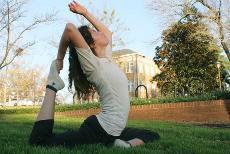Prayer, zen, mindfulness, concentrative, yoga, chakras.
The list can go on and on with the different types of meditation.
They’re all a little different and use varying techniques, but they all
do the same thing, according to Kaci Torres, a senior in economics.
“Meditation is about keeping your mind and body connected,” Virginia
Newton, a predoctoral intern at the Student Affairs Counseling Center,
said.
She said it is important to know the body is interconnected and
different parts influence each other. Mindful meditation, the form of
meditation Newton focuses on, is often used as a therapeutic technique,
according to her.
“A lot of psychological problems can be helped through mindful
meditation,” Newton said.
Torres said she practices zen meditation, which is similar to mindful
meditation, to better her social interactions. She also said she
meditates a little before playing a sport to improve her performance.
Meditation can be practiced through a religious exercise, like prayer,
as well. Betsy Diller, a sophomore in physics and English said she
considers prayer both spiritual and meditative.
“I got into both sides of it,” she said.
According to Diller, she meditates at least an hour a day — half an
hour in the morning and half an hour at night — even when she is busy.
She said she usually recites the rosary. When she is busy, she said she
makes an extra effort to meditate then because that is the time when it
is most important.
Aaron Mangal, a senior in business management, on the other hand, said
he probably hasn’t meditated in a month because he has been busy. He
said exam time is an important time to meditate but he doesn’t because
he hasn’t made it a habit.
Meditating about once or twice a week for an hour is a nice medium for
Torres, she said.
“[I meditate] when I feel like I need it or when I have the time,”
Torres said. “It helps me let things go.”
It improves a person’s quality of life, both mentally and physically,
according to Mangal. He said if only 10 percent of people did it, there
would be better productivity because stress is physiologically
detrimental.
“Meditation reduces stress, improves focus and makes you feel better,”
Mangal said. “It’s a good way to help you take a break from reality.”
Meditation helps people slow down and look at things a little
differently, Torres said.
Meditation improves a person’s ability to focus at the task
at hand and the present moment, according to Newton. She said this can be helpful for students when they’re studying because they can tune out distractions,
like people talking, music and TV.
Diller said she doesn’t have trouble finding a place to meditate,
regardless of where she is.
“I often do it on benches by the Brickyard,” she said.
She also said she meditates in a corner in the library or at home.
Torres said she meditates in her room. She said she doesn’t usually
meditate during the day because people laugh at her. However, she does
enjoy meditating outside sometimes.
“Nature in general is good,” Torres said.
Mangal agreed with Torres on the importance of nature. He said his next
step in meditation is doing it outside. But, for the time being, he
said he mostly meditates in a chair in his room, even though he does meditate in
class occasionally.
“Sometimes I do it in the middle of class if I need to concentrate for
whatever reason,” Mangal said. “You can do it and nobody even know.”
Even though it is possible to meditate without others knowing, Torres,
Diller and Mangal all said they would appreciate a group provided for
students to meditate. Plus, a group could encourage others to take up
meditation.
“It would be helpful to a lot of students to sit back and clear their
minds,” Diller said.








